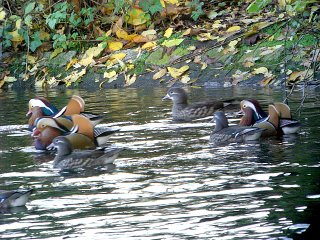


The past week has been very quiet in the park, with nothing outstsanding seen. These Atlantic weather systems seldom bring any birds of note. There is still the odd Chiffchaff and Blackcap, Goldcrests can be seen especially around the entrance to Queen Mary's Gardens, area 12. There is also a chance that the Firecrest is still present in the areas surrouding the Bandstand. The Tit flock has been present all week, but viewing them has been harddue to the brisk wind and rain.
Today; 12 Mandarins.
24 Red Crested Pochards.
1 Pintail.
5 Ruddy Ducks.
1 Pair Eygptian Geese.
2 Little Grebes.
5 Great Crested Grebes.


Comments
I've newly discovered the park's website - it's very good, keep up the good work!
One thing - how do you know with say, red crested pochards, which ones belong to the park, and which are wild / semi-feral - is there a story behind this population? Is it safe to assume any other slightly unusual waterbirds are part of the collection, e.g. goosanders, whether they're in the enclosed bit of the lake or out on the boating lake?
Cheers,
Piers
We do have a large number of RC pochards over 20 is not unusual. I think if people are counting sightings of RCP's in the Lea Valley or Colne Valley I think they are of dubious origin. I think the ones in Regents have come from St James's Park. They now breed quite readily here. As I am in charge of breeding the waterfowl here I have to dispose of hundreds of their eggs. However some that breed in vegetation and not my duck boxes manage to rear their young. I have 4 females 2 on the main lake(put there in spring) and 2 in the NE arm, though 1 has recently found its way to and from the main lake.
Last year a wild bird turned up and eventually fed with the collection birds.
The ducks that are of wild origin are normally Shoveler, Gadwall, Teal, Wigeon(1st W), Ruddy Duck(on main Lake), Northern Pintail are part of a feral population in the London area.